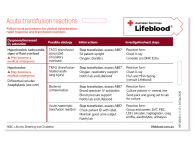Don’t have an account?
Select the donation type you’d like to make
Transfusion-associated circulatory overload (TACO) is a common transfusion reaction where pulmonary oedema due to excess volume or circulatory overload results in the patient experiencing acute respiratory distress.
TACO is a clinical diagnosis and clinical definitions may include evidence of positive fluid balance or cardiac involvement such as left heart failure, elevated blood pressure, or tachycardia.
It is the leading cause of transfusion-related deaths reported to the US Federal Drug Administration (FDA), accounting for 58 (or 32%) of reported fatalities from 2014-2018.
TACO is also responsible for most deaths and major morbidity reported to the UK Serious Hazards of Transfusion (SHOT) scheme. In the period 2010 to 2023, there were 126 deaths (39.4% of fatalities) reported.
However, TACO remains poorly understood and almost certainly under-reported.
When to suspect this adverse reaction
The ISBT/IHN/AABB 2018 criteria for diagnosis of TACO states that the patient should have acute or worsening respiratory compromise and/or evidence of pulmonary oedema (A and/or B below) during or up to 12 hours after transfusion and the presence of a total of 3 or more of the following criteria A-E:
Required criteria
A. Acute or worsening respiratory compromise e.g. tachypnoea, shortness of breath, decreased O2 saturations; and/or
B. Acute or worsening pulmonary oedema based on:
- clinical physical examination (e.g. bilateral crackles, orthopnoea, cough) and/or
- chest X-ray (e.g. worsening pleural effusions, bilateral Kerley lines, alveolar oedema, enlarged cardiac silhouette) and/ or non-invasive assessment of cardiac function (e.g. echocardiogram).
Additional criteria
C. Evidence for cardiovascular system changes not explained by the patient’s underlying medical condition, e.g. tachycardia, hypertension, widened pulse pressure.
D. Evidence of fluid overload e.g. positive fluid balance, response to diuretics.
E. Supportive result of a relevant biomarker such as elevated B-type natriuretic peptide level (e.g. BNP or NT-pro BNP) above the age group-specific reference range and greater than 1.5 times the pretransfusion value.
Usual causes
TACO is typically seen in patients who rapidly receive a large volume of transfused products or those with underlying cardiovascular or renal disease.
The risk generally increases with the number of blood products that are transfused.
Patients over 60 years of age, infants and the severely anaemic are particularly susceptible.
TACO occurs in approximately 1% to 2.7% of patients receiving transfusions.
Investigation
- Perform chest X-ray to assess for pulmonary oedema.
- Assess other cause(s)/contributors to pulmonary oedema (e.g. renal function, sepsis, non-cardiogenic pulmonary oedema (TRALI).
- Determine B-type natriuretic peptide (BNP) or NT pro-BNP levels – a normal post-transfusion level is not consistent with diagnosis of TACO.
- Consider echocardiogram to assess cardiac function (e.g. right atrial hypertension).
Monitoring patients and observing vital signs during transfusion is a key in the early recognition and diagnosis of TACO. Comparison with observations and net fluid balance from the 24 hours before the transfusion may be valuable.
TACO is frequently confused with transfusion-related acute lung injury (TRALI) and it’s possible for these complications to occur concurrently. Both may exhibit new onset hypoxaemia and new or worsening bilateral infiltrates on chest X-ray consistent with pulmonary oedema.
Hypertension is a constant feature in TACO whereas it is infrequent in TRALI.
What to do
Stop transfusion immediately and follow other steps for managing suspected transfusion reactions.
Place the patient in an upright position and treat symptoms with oxygen, diuretics and other cardiac failure therapy.
In serious cases, mechanical ventilation and treatment in the intensive care unit (ICU) may be required.
How to prevent
In susceptible patients at risk for TACO (elderly or paediatric patients, patients with severe anaemia and patients with congestive heart failure or renal disease), transfusion should be administered slowly and consideration given to the use of a diuretic.
A formal pre-transfusion risk assessment (TACO checklist) should be undertaken whenever possible for all patients receiving blood transfusion especially if older than 50 years or weighing less than 50 kg.
Following the principles of patient blood management (PBM) and avoiding unnecessary transfusions in non-bleeding anaemic patients should reduce the number of transfusions and therefore potentially reduce the incidence of TACO.
Updated July 2025



